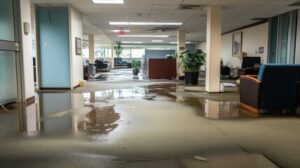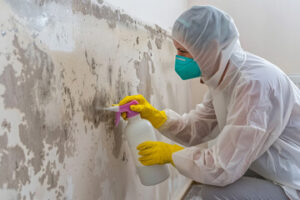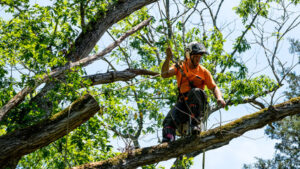Moisture intrusion leads to structural damage, deteriorates surfaces, and threatens the integrity of buildings. The impacts of water damage can be costly for businesses and homeowners alike.

Look for dark spots and stains on walls and ceilings. Affected areas can feel soft or mushy to the touch. Darker stains and blemishes with rings indicate older damage. Contact Water Damage Salt Lake City UT for professional help.
When water damages building materials, it causes a wide range of problems that impact the structure and usability of a property. Depending on the material and length of time it is exposed to moisture, damage can range from minor stains to severe structural problems and corrosion of metals.
Almost all building materials are susceptible to the damage caused by water. Wood easily absorbs water, and prolonged exposure can weaken the integrity of wooden structures. Drywall and plaster soak up moisture, and can become crumbly or lose their insulating properties. Carpeting and flooring are also affected by water damage, often becoming discolored or warped.
Water damage can have significant effects on a home or commercial property, including lowering the value of the property and inhibiting its ability to function as intended. For example, visible signs of water damage like stains on ceilings or walls or peeling paint can deter potential buyers from making an offer, and can make the home feel less appealing and well-maintained.
The problem can be further compounded if the home or office is located in a flood-prone area, as well as for buildings that use cellulose building products such as Oriented Strand Board (OSB). These materials are extremely sensitive to water damage, and can lead to mold, mildew, and rot if not addressed quickly.
Even clean water can cause serious problems. When a pipe bursts or an appliance leaks, the water is considered Category 1 by most insurance policies. This is water that doesn’t pose a health threat, but quick action is needed to prevent further damage. This is because water will continue to wick from wet to dry building materials until there is no longer any dry materials left, and can cause further damage in the process.
Warped or Buckled Walls
The structural integrity of a property can be compromised by long-term water damage. Drywall, wood, and other building materials can become swollen or warped from excessive moisture exposure. This can result in a number of issues including uneven surfaces and even the collapse of walls or ceilings. Detecting these warning signs and seeking professional help is vital to protect the safety of those living in the property as well as prevent long-term damage.
One of the first signs of a potential issue is staining or discoloration on wall and ceiling surfaces. Yellow or brown stains indicate that water is seeping through the surface and can cause paint to bubble, peel, or crack. Darker stains typically indicate that the water damage is more recent while lighter stains suggest it may be older. Touching the affected areas can also be a good indicator of the age of the water damage. Newer drywall can feel soft or spongy while older drywall tends to be harder and more dried out.
Water damage can also result in a musty odor, as mold and mildew thrive in damp environments. The presence of mold growth and a musty smell is an indicator of a serious water damage problem that needs to be addressed promptly.
Buckling or warping walls are another significant warning sign of water damage that requires immediate attention. This distortion occurs when the drywall or other material swells due to prolonged exposure to moisture, which can cause the wall panels to lose their shape and appear protruding from the structure or caving in in extreme cases.
Pest Infestations
When water damage occurs, it can create a perfect environment for pests to infiltrate the home. For example, mold and mildew thrive in damp conditions, and they can attract fungus gnats, booklice and other pests. Moreover, mildew and mold can also weaken building materials and encourage premature rot.
Similarly, wood-destroying termites invade buildings that have been weakened by water. If you have spotted mud tubes along the foundation walls or heard hollow-sounding wood, then you may have a serious termite infestation problem that requires professional treatment to address.
Another common cause of property damage that leads to pest infestation is clogged sewer lines. When drain pipes become clogged, sewage backs up and enters the home through toilets or sinks. This contaminates the indoor air, creating an unpleasant musty odor and posing significant health risks for your family.
Water damage can also lead to the development of a variety of pests in attics, basements and garages. These spaces can be filled with cluttered items that provide ideal hiding spots for rodents, spiders and other pests. Regular decluttering can help minimize the number of hiding places that these pests have access to in your home.
Lastly, a flooded basement or attic can create a breeding ground for insects that enjoy moist environments, such as silverfish and earwigs. These pests can feed on any cellulose material found in your home, including the walls and insulation of your house. Regular moisture inspections and identifying leaks as soon as they occur can reduce the risk of these pests gaining entry into your home. In addition, it is recommended to run a dehumidifier in your basement and declutter the attic on a regular basis to control humidity levels.
Health Hazards
Water damage creates an ideal environment for the growth of harmful microorganisms, including mold and bacteria. These pathogens thrive in damp environments and can contaminate living spaces, causing various health issues from skin infections to serious gastrointestinal diseases.
These contaminants are most concerning for occupants with existing respiratory problems, such as asthma and allergies, which can be exacerbated by exposure to mold spores. Even for those who do not have existing conditions, mold spores can still cause breathing difficulties and itchy eyes and nose. This is especially problematic for multi-family residential buildings where residents share spaces, resulting in multiple individuals experiencing these symptoms at once.
The damp environment created by water damage also promotes the proliferation of bugs, fungus, and rodents. These pests are drawn to moist areas and will eat away at building materials like insulation, carpeting, and furniture. This can lead to further structural damage and pose a safety risk for residents.
In addition to these health and safety risks, the upheaval caused by water damage can impact occupants’ mental well-being. The disruption to daily routines, concerns about property loss, and the uncertainty of how long the restoration process will last can all contribute to stress and anxiety.
The structural damage caused by water damage can lead to a number of problems, from sagging floors and ceilings to complete structural failure. This can threaten the safety of occupants and lead to costly repairs. In addition, the moisture intrusion can gradually erode building materials, leading to further problems like cracking and warping over time. These deteriorating materials can weaken the foundations, walls, and roofs of your facility, putting the structure at risk for collapse or structural failure.
Financial Impact
Water damage can be a major financial burden for homeowners and commercial property owners. It often requires costly structural repairs, restoration, and replacement of damaged materials and systems. It can also depress property value and lead to legal liabilities and lost revenue.
In homes, long-term water damage can result in hefty repair bills, ruined belongings, and decreased home resale value. Structural damage from floods, leaky roofs, and plumbing failures may require costly repairs to drywall, insulation, and floors. The resulting damp environments can promote the growth of harmful mold and bacteria, which are expensive to remove.
Commercial properties that suffer from long-term water damage may face high operational costs due to forced closures and lost revenue. Excess humidity caused by flooding or leaky roofs will force HVAC systems to run day and night, driving up energy expenses. Untreated water damage can also violate workplace health and safety regulations, resulting in costly fines.
While water damage is common, many people underestimate its potential impacts. The long-term effects of water damage are far more devastating than immediately visible, and it is essential to take preventive measures and enlist professional help as soon as possible. Taking the time to understand these impacts can help you minimize your risk of damage and protect your home or business from costly consequences.




